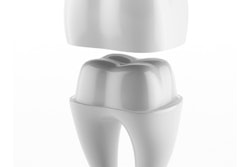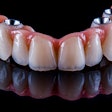Er:YAG laser irradiation can effectively debond porcelain veneers while preserving tooth structure, according to a study in Lasers in Surgery and Medicine (December 2011, Vol. 43:10, pp. 965-974).
Using Er:YAG lasers to remove porcelain veneers has not been previously described in the scientific literature, according to the study authors, from the University of California, San Francisco School of Dentistry.
They used Fourier transform infrared (FTIR) spectroscopy on 10 flat veneer samples (IPS Empress Esthetic and e.max Press HT, Ivoclar Vivadent) to assess which infrared laser wavelengths transmit through a veneer. They ultimately chose the Er:YAG, and measured Er:YAG laser energy transmission (wavelength of 2,940 nm, 10-Hz repetition rate, pulse duration of 100 µsec at 133 mJ/pulse) through different veneer thicknesses.
The study authors bonded 24 veneers to freshly extracted and prepared incisors, then determined how much laser energy was necessary for debonding and debonded the veneers with the laser. They measured the time needed for total debonding and used light microscopy to assess any damage to the underlying tooth structure.
All 24 bonded veneers were completely removed with an average removal time of 113 ± 76 seconds. Underlying tooth structure was not damaged. The debonding mainly occurred at the cement/veneer interface. None of the e.max veneers fractured during debonding, while 36% of the Empress Esthetic veneers did.
"Maintaining veneer integrity possibly depends on the flexure strength of the veneer porcelain," the study authors concluded.



















